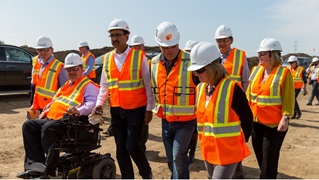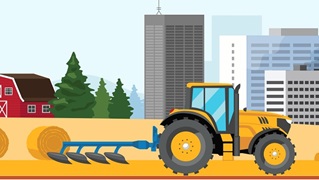‘Engagement is happening, and this is the way it should happen’
Enbridge’s Line 3 Replacement Program outreach is worth celebrating, says Assembly of First Nations (AFN) spokeswoman
The shovels are now in motion. The conversation has been going on for years.
Earlier this month, the Line 3 Replacement Program broke ground in Canada, with construction beginning in regions of Alberta and Saskatchewan.
And in the three years since Enbridge announced this project, we’ve engaged in an ongoing dialogue with landowners and tenants, communities, various levels of government—and about 150 Indigenous groups based as much as 300 kilometres from the pipeline right-of-way.
“I’m very honoured to be here today. I’m very honoured to bring an Indigenous voice today, and to actually say engagement is happening, and this is the way it should happen,” said Lowa Beebe, public relations liaison with the Alberta office of the Assembly of First Nations (AFN), during a news conference and right-of-way tour near Hardisty, Alberta last week to acknowledge that shovels are officially in the ground on the L3RP.
“Line 3 is unique,” she added. “I want to stand here and celebrate today, and really say they’ve done a fantastic job, they’ve done a great job, and they’re continuing to do a job.”
The L3RP, with a $5.3-billion Canadian component, is not only the largest project in Enbridge history—it’s also benefited from the most extensive engagement program we’ve ever attempted.
That outreach program has resulted in:
- About 20,000 direct and indirect recorded engagements at open houses, presentations, workshops, in-person meetings, trade shows and other scenarios;
- Agreements with 100 percent of right-of-way landowners;
- The support of the Canadian Association of Energy and Pipeline Landowner Associations (CAEPLA), with a partnership that involves annual landowner-focused workshops; and
- Hundreds of modifications to the project.
As for Indigenous engagement, Enbridge’s L3RP team has negotiated agreements covering 70 Indigenous communities or groups. Additionally:
- We anticipate more than $50 million in contracting and employment opportunities for Indigenous workers;
- About 350 Indigenous businesses have been connected to potential L3RP work opportunities through our Indigenous Contractors database;
- More than 150 people have completed our L3R Training-to-Employment program;
- Indigenous monitors and liaisons will be employed through the course of construction; and
- Nearly $8 million has been invested in Indigenous community projects, including environmental and sustainability initiatives.
“I’ve been privileged and I’ve been honoured to be in those meetings . . . (these are) relationships that Canadians don’t see that are getting built,” said Beebe. “There are dozens of contractors . . . that are First Nations and Indigenous, that will be working along this line, and that’s something that we can celebrate today.”
During the construction phase of this project, more than $3 million will be invested in community-focused initiatives in 2017 and 2018 in towns across Canada—initiatives that include training and equipment for fire departments, literacy programs for kids, and upgrades to playgrounds and campgrounds.
“We are very, very pleased with the extensive, thoughtful and supportive engagement we’re having with communities all along the right-of-way,” said Leo Golden, Enbridge’s Vice President of Major Projects.
“We focused on early discussions from the very outset—listening to people’s views, making changes to address concerns, and ensuring that communities and our Indigenous partners would benefit through jobs, capacity building, training and procurement opportunities.”
(TOP PHOTO: Lowa Beebe, public relations liaison with the Assembly of First Nations (AFN), and Leo Golden, Enbridge's Vice President of Major Projects.)










